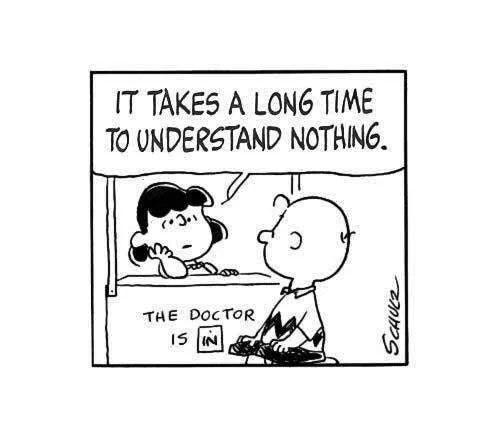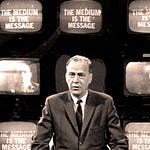Transcript: Edited and Annotated
There's no headline for this podcast (except “No Headline”). As the Executive Editor of a publication dedicated to the study of gaps between stories and realities, I don't enjoy reducing stories to headlines. The first problem with any blog post is always in the headline, which reflects the web of unexamined assumptions that we bring to naming the subject and establishing its relevance.
Formally, according to the M2 Dialogue editorial calendar, this is the third installment of my monthly newsletter about gaps between theory and reality. The first edition focused on the state of dialogue. In the second installment, I performatively hyperventilated about the state of attention. In this edition, I was technically supposed to write about Messages From the Future: A Sketch of ‘Unknown Knowns’. Instead, one thing led to another, and I brought you this post about “nothing”.
I changed course for a couple of reasons. First, the messages I am currently summarizing aren't really from the future. They are from the here and now. But they are anchored in a perspective that seeks to transcend the false theories of time, space and human nature that still govern our institutions (and probably always will). Second, I've been rethinking the quote that had inspired the idea of messages from the future. The quote is from William Gibson:
The future is already here. It's just not very evenly distributed.
I'm rethinking this quote in light of an even briefer aphorism — Amor Fati (love of one's fate) — because I don't want to encourage any consumer of my content either to fear or to pursue someone else's future.
However, the “Messages” I’m currently summarizing are important, regardless of their spatio-temporal point of origin, and I doubt that the study of ‘Unknown Knowns’ will ever lose relevance. I intend to bring you the messages before I return to my cave to observe the unceasing redistribution of the future. Stay tuned.
But since this is a post about nothing, the most appropriate call to action here is to invite M2 Dialogue subscribers to book a Dialogue as a Service (DaaS) session focused on nothing.
If you book one hour with me this month — but book before sunset this Friday night (3/3) — I will dedicate at least three hours of my infinitely valuable time to help you build the most fruitful relationship with nothingness.
If money is an issue, feel free to book a complimentary session.
If booking a session feels premature, subscribe and stay tuned for messages from the future.
I’ve now exposed you to three calls to action. Shameless! But let’s not overdose. People who appreciate my work enjoy it responsibly. If you’re still reading this post about nothing, you are definitely on the tail end of the attention economy bell curve. You should definitely subscribe and email me at m2dialogue@substack.com to introduce yourself.
With that final call to action, I leave you with the sources below to start your reacquaintance with nothingness.
Meanings of Nothing: Annotated Sources
How Nothingness Became Everything We Wanted (New York Times - January 19, 2021)
Quarantine has been widely regarded as a radical break in our daily lives and the ways we interact with the world, but in truth it’s simply an overdose of the indulgences a certain segment of the population was dabbling in already. We’re a little like kids caught with a cigarette, forced to smoke a whole pack at once.
The emotional underpinnings of this economy have been best theorized by Venkatesh Rao, a 46-year-old writer and business consultant, who has become something of a negative futurist, a thinkfluencer’s thinkfluencer. Rao got his Ph.D. in 2003 in systems theory from the University of Michigan, but in 2007 he founded a blog called Ribbonfarm, which has gained a reputation for seeding ideas that become common wisdom months or years later. In a series of popular blog posts beginning in March 2019, he prophetically described the inclination to hole up at home with Netflix binges, video games and Seamless deliveries as “domestic cozy”: “a pre-emptive retreat from worldly affairs for a generation that, quite understandably, thinks the public sphere is falling apart.”
Ketamine Therapy Is Going Mainstream. Are We Ready? (The New Yorker - December 29, 2021)
In the eighties, the drug’s best-known enthusiast was John C. Lilly, a doctor and psychoanalyst perhaps most famous for using sensory-deprivation tanks and dabbling in human-dolphin communication. Lilly became addicted to ketamine: a researcher who crossed paths with him at the Esalen Institute, a retreat in Northern California, recalled Lilly spending most of his time in his Volkswagen minibus, where he was evidently injecting himself multiple times a day. (Lilly said that he stopped using the drug in his early sixties, on the orders of extraterrestrials, but he resumed taking it later in life. He died in 2001, at eighty-six.)
Researchers began studying it as a treatment for depression, and, in 2006, the National Institute of Mental Health concluded that a single intravenous dose of ketamine had rapid antidepressant effects. Around three hundred clinical trials have since been held; the broad consensus is that ketamine relieves symptoms of depression for a period that can last days or weeks, during which time talk therapy often proves more effective than normal. Ketamine is what’s called a “dirty drug,” meaning that it acts on different parts of the brain at once, and there are several theories about how it works against depression, but most focus on its effects on certain receptors in the brain, and on the neurotransmitter glutamate.
Change is not merely a chemical by-product, he told me, and diagnostic categories help only up to a point. He believes that ketamine’s particular power is in the way that it offers a “subjective time-out.”
The feeling lasted a little more than two weeks, and then it went away. The memory of what it had felt like lingered a bit longer, and then it went away, too.
What Is Nothing? (Vice - October 31, 2018; Trigger Warning: This page is dangerously polluted with advertising.)
“In quantum field theory, which we think is our best way of describing the universe that we have right now, empty space is kind of interesting,” he explained. “Even if it’s as empty as it can be, there are still quantum mechanical [properties]—they’re just in a zero-energy state not doing anything. But you could probe the vacuum, as particle physics does, and discover its properties.
The 4 fundamental meanings of “nothing” in science (Big Think - December 22, 2022)
Most of us, when we talk about nothing, refer to a state where the thing we're referring to doesn't yet exist. But absolute nothingness, where space, time, and/or the laws of physics don't exist, is only a philosophical construct, without physical meaning. Does the Universe truly create something from nothing? That depends on what your definition of nothing is, and which of the four definitions you're using.
Highlihhts and Annotations
Even when ketamine provides an enjoyable subjective timeout, the quest for a better oblivion will never arrive through depoliticized therapies.
The commodification of nothingness: LOL nothing matters.
Reexamining the membrane separating the internal from the external.
Sad “Happy Hours”.
Streaming video as a drug and a cultural glue.
The culture of negation and numbness.
The Ketamine Culture.
The “swaddled life” sounds unattractive, unless the alternative is unspeakable horror.
Software has been eating the world for a long time. Are we being excreted now?
If the “shared world is increasingly intolerable”, shouldn't we join forces in a fight for universal basic access to ketamine?
Is the optimism-pessimism spectrum useful in a post-reality world?
How did something come from nothing? An answer, in Latin: “In principio verbum erat. Et verbum caro factum est.”











Share this post